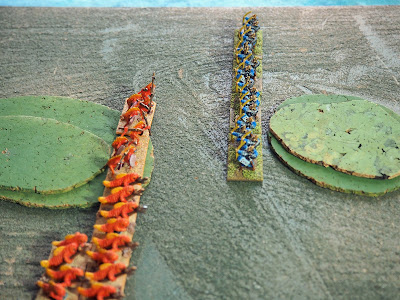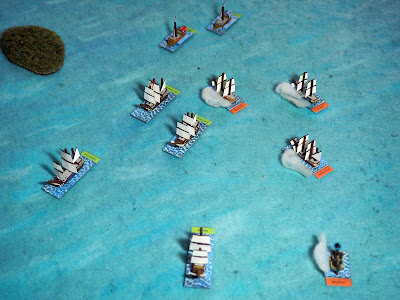Yes, it's back!
Thursday, 30 September 2021
Elves vs Fishmen
Over the weekend I found myself taking a few photos of HOTT elements to use as diagrams for a discussion on the HOTT Facebook group. Since the armies were out on the table, and it was too wet to go for a walk this lunchtime, I set up a game using them
So this is a battle between the Fishmen (left) and the Elves. I randomised both armies and ended up with two two-point terrors - armies made up entirely of the 'vanilla' 2AP elements. The Fishmen fielded six spears, four shooters and two warband, whilst the Elves had four spears, four shooters and four riders. Both armies had a spear general, and the Elves defended.
The Elves put their spears in the centre, the riders on one flank and their archers on the other. The Fishmen lined up their shooters against the enemy cavalry, used the warband to cover the flank opposing the Elven archers and also put their spears in the centre.
Next time they need a better plan.
Saturday, 25 September 2021
The Battle Of Bantam
Strictly I should say that this is the Battle of Bantam Bathtubbed, since it's a little scaled down. And the idea of a bathtubbed naval battle does appeal, it has to be said.
But, anyway, this is the result of another foray into the archives at Three Decks. It was fought off the northwestern tip of Java on 27th December 1601, when eight Portuguese galleons from Goa, supported by some twenty or so fustas (small galleys) under André Furtado de Mendonça met an exploration force of five Dutch vessels under Walter Harmensz. The Portuguese were forced to retreat. It seems there were skirmishes into the New Year, but eventually the Portuguese were driven off, allowing the Dutch to establish themselves in the East Indies.
I scaled the battle down to match my available ships and table-size, plus to reduce the Portuguese force. I went with the following:
Portuguese - Four Carracks (Sao Salvador (flag), Santa Cruz, Sao Simeao, Nazare), two Fustas (Domas, Serang)
Dutch - Three Cromsters (Gelderland (Flag), Utrecht, Zeelandia) plus a Jacht (Wachter)
All ships were lifted straight from the book aside from the Fustas which I rated as Q2 C1 with Galley, Shallow Draft and Yare. Domas and Wachter both had the Relay trait which extends the flagship's command radius.
I set up the terrain and wind randomly. The Dutch got initiative and chose a corner, then the Portuguese chose theirs.
Here's the Portuguese, heading south-west on an east wind. At the back is Domas, followed by Serang. In the middle is Santa Cruz, followed by the flagship Sao Salvador. And in the foreground is Nazare, followed by Sao Simeo.
(In game terms the Zeeland scored a 6:1 in their favour when they initiated their boarding action, crippling the Portuguese galley. But the Portuguese got enough activations to respond with a counter-boarding action, and also scored a 6:1, inflicting a crippling hit on the Zeeland. The Zeeland failed an activation on the next turn and struck)
The undamaged Sao Salvador followed the other two carracks rather than try to turn and engage the Utrecht. This left the Dutch in command of the field of battle. However two of their ships were crippled and had struck, leaving them in a bad way. The Portuguese had lost both fustas, and one carrack wrecked early on. So on the whole neither side could claim a victory here; the Dutch would have to contend with the Portuguese coming back, whilst the Portuguese had lost three of their six vessels.
This was a tough, and frustrating, battle for both sides. The Dutch gunnery is potentially good, but the Portuguese ships are tough and difficult to damage. However their ability to activate is abysmal, and they turn very slowly. A good job as if they can fire at a decently short range their gunnery is potentially devastating. The fustas were unexpectedly good; despite their low combat value they could give the Dutch ship a run for their money in a boarding action and if two could have teamed up on one Dutch ship they would have taken it quickly and easily.
This is one I'll probably try again.
Postscript: One of the five Dutch ships in the original battle was the Duyfken, which a few years later became the first European vessel to sight and land crew on the coast of Australia. There's a replica of her on display in Sydney.
Thursday, 23 September 2021
The Capture Of Santa Catarina
One site I like to browse through from time to time is Three Decks, and the other day I came across this action - The Capture of Santa Catarina. You'll notice that apart from a one line description of the location and end result there is basically no information given aside from the names of the ships involved. This makes it an easy action to set up as a game, since I can just make the whole thing up.
I decided to run it as a Galleys & Galleons 'Blockade Runner' scenario - the Santa Catarina, a Portuguese carrack, would have to run the gauntlet of two Dutch cromsters, the Witte Leeuw and the Alkmaar. I ran the carrack straight out of the book, but in order to get the points to come out for the scenario setup I dropped Shallow Draft and Master Gunner from the cromsters, but added Carronades to make up for the loss of the latter trait.
I set up the terrain randomly and ended up with a chain of islands from one corner to the other. The Santa Catarina gets to choose the corner it starts in and the wind direction, and I went for this, with the wind on the starboard beam (from the East). The Dutch have to set up on the centreline, facing directly into the wind. They deployed to cover both passages through the islands.
So a win for both side. Each game took 15-20 minutes to play, so it was a perfect lunchtime entertainment.
Tuesday, 21 September 2021
Stora Kronan vs Sophia Amalia - Again
With all the ships still on the table it was a simple thing today to run yesterday's action again. Once again the Swedes are on the left - Draken, Stora Kronan and Hieronymous with Fenix shadowing them - and the Danes on the right - Christianus V, Sophia Amalia and Dannebroge, accompanied by Hommeren.
Both squadrons stayed fairly organised this time. The Swedes bore down on the Danes, who held their line.
... and collided with Sophia Amalia. The resulting damage was too much for the surviving Swedish battleship, and it struck.
This just left the Swedes with the Fenix, which fled. Neither frigate had been seriously engaged.
The Swedes lost all three of their ships of the line. The Danes had been seriously battered though, with both Christianus V and Sophia Amalia being crippled. Only Dannebroge had escaped serious damage.
This was a much more satisfying game, with both squadrons maintaining some semblance of order for most of the battle, but a lot of it hinging on failed activations leading to rolls on the terrible All At Sea table.
I made two small changes. Excess Hull criticals would only cause a ship to sink if it was, or had previously been, holed. And if a ship took excess damage from a collision, it would sink on a D6 roll of 1-3 and remain afloat but strike on a 4-6. I'll write up my excess damage rules and add them to my house-rules at some stage.




























































